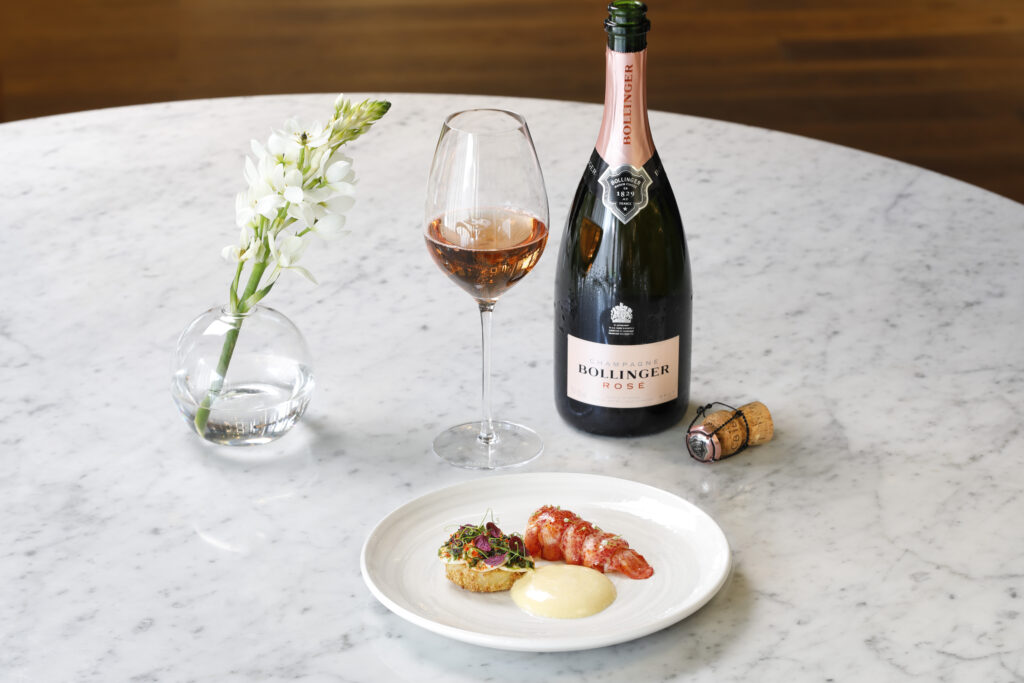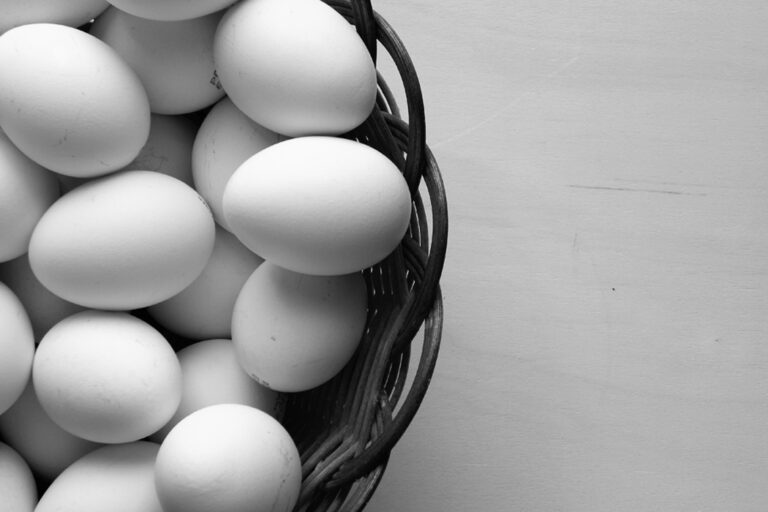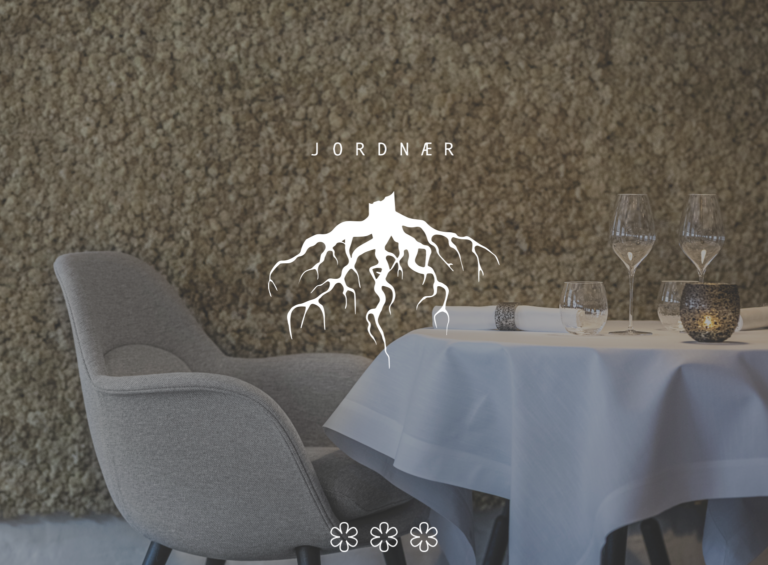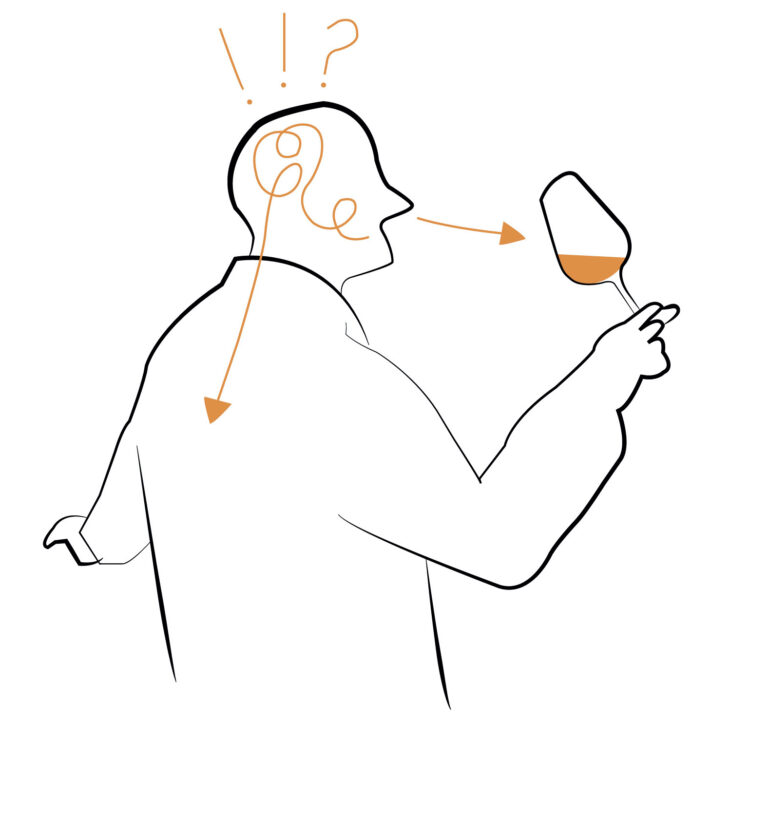On September 20, the final of the Lily Bollinger Award 2021 took place and Frida Winters was named Sweden’s best female sommelier. Before the final, Ida Bauhn from the Swedish Culinary Team (Kocklandslaget) was commissioned to produce an exclusive menu where all dishes would go well with Bollinger Rosé. For the main course, chanterelle and truffle stuffed chicken with cabbage terrine and buttered chicken sky was served – read on to take part in Ida Bauhn’s exclusive recipe!


‘I wanted to produce a menu with flavors that really harmonize with Bollinger Rosé and use ingredients in season, and I immediately felt that my main course needed to have very nutty and buttery notes. Chanterelles and cabbage really shine in my autumnal chicken dish that goes perfectly with a glass of Bollinger Rosé’
says chef Ida Bauhn.
The menu consists of baked celeriac with lobster and browned butter sabayonne, chanterelle and truffle stuffed chicken with cabbage terrine and buttered chicken sky and clafoutis with boiled beets and goat cheese cream.

Baked celeriac with lobster and browned butter-sabayonne
When the final of the female sommelier competition Lily Bollinger Award 2021 took place, Ida Bauhn from the Swedish National Chefs’ Team prepared this incredibly luxurious starter. Now you get a chance to try for yourself and experience food at master class level. Match with a complex and powerful rosé champagne – which is also part of a fantastic browned butter sabayonne!
Cooking time: Over 60 min
For 4 servings
Ingredients
- 2 live lobsters
- 5 dl neutral rapeseed oil
- 2 tablespoons tomato puree
- 10 g finely chopped chives
- butter for frying
- salt
Hazelnut gravel
- 5 dl cold water
- 100 g peeled hazelnuts
- Cold pressed rapeseed vinaigrette
- 1 dl cold-pressed rapeseed oil
- ½ dl freshly squeezed lemon juice
Baked celeriac
- 500 g butter
- 1 large celeriac
Browned butter-sabayonne
- 300 g browned butter (from the celeriac)
- 80 g Bollinger Rosé (no. 7755, SEK 659)
- 4 egg yolks
- 2 whole eggs
- freshly squeezed lemon juice
For serving
- algal powder
- shisokrasse
- pea shoots
Cooking
- Kill the lobster by sticking the tip of the knife through its head between its eyes. Cut off the tail and break off the claws. Tie the tails together in a straight position. Carefully place the lobsters in salted boiling water, large enough so that the boiling does not stop. Take them up after 2 minutes, put in an ice bath and let cool. Then put the claws in the same water and cook until they are ready, about 9 minutes. Take up, put in ice bath and let cool. Finally, put the lobster heads in the water and cook for about 9 minutes.
- Peel the lobster tails using scissors to keep them intact, as well as the claws. Cut the claw meat into smaller pieces. Store in the refrigerator.
- Pick the rum out of the lobster’s head (goes from greenish to orange when cooking). Dry the rum in the oven at 60 degrees (hot air) until it is completely dry and can crumble, it takes about 2 hours.
- Lobster oil: Put lobster shells and the cooked heads in a large saucepan. Add the tomato puree and heat. Pour on the rapeseed oil just before everything starts to get color. The oil does not have to cover the shells completely, but still so that it feels abundant. Let stand for 1 hour on medium heat. Stir occasionally so that it does not burn to the bottom, it is important to keep the red / orange color. Strain the oil through a fine-mesh strainer. If necessary, taste with salt. Let cool. Store in the refrigerator.
- Mix the claw meat with chives and 1 tablespoon lobster oil. Taste with salt. Store in the refrigerator.
- Hazelnut gravel: Dissolve 2 tablespoons salt in the water. Put the nuts in a bowl and pour on the water. Let stand for 30 minutes. Strain off the water. Spread the nuts on a baking sheet lined with baking paper and roast in the oven at 170 degrees (hot air) until they have a nice color, about 15 minutes. Let cool. Mix the nuts lightly in a small food processor or blender.
- Cold-pressed rapeseed vinaigrette: Mix rapeseed oil, lemon juice and teaspoon salt.
- Baked celeriac: Brown the butter in a large, thick-bottomed saucepan (so that the butter does not bubble over). Stir occasionally so that it is evenly browned. Remove from the heat when the butter has turned golden. Peel and cut the celeriac into 4 cm thick slices. Punch or cut out 1 round per slice, approx. 3 cm in diameter and place in an ovenproof dish. Pour over the butter so that it covers. Put in the oven at 120 degrees (hot air) until the rounds are soft, but still hold together, about 25 minutes. Cut the remaining celeriac into mm-thin slices and punch or cut out 12 slightly smaller rounds than the baked version.
- Browned butter-sabayonne: Heat the browned butter (from the celeriac) and the wine to 60 degrees in a saucepan each. Put egg yolks and cracked eggs in a mixing bowl. Pour on the wine and mix airily with a hand mixer. Add the butter in a stream while continuing to mix. Taste with salt and possibly lemon juice, if the acid needs to be raised, when everything has come together and thickened slightly. Pour the sauce into a siphon and load with two cartridges. Keep the siphon warm at 60 degrees, for example in a water bath, it is important that the sauce maintains the temperature. If the siphon is missing, beat a hollandaise on only the yolks and exclude the whole eggs.
- When serving: Fry the lobster tails in 2 tablespoons lobster oil and a pinch of butter. Make sure that they are not overcooked, 2-3 minutes per side is enough. Divide the tails along. Take the celeriac rounds from the butter and roll in the hazelnut gravel.
- Layout: Place 1 tablespoon of clove meat per plate and 1 halved lobster tail on top. Place a baked celeriac next to it. Top with the thinly sliced celeriac that has first been mixed with the rapeseed vinaigrette. Powder over rum and algae powder. Garnish the celeriac with shisrocasse and pea shoots. Serve with the browned butter sabayon from the siphon.
- Tip! Everything except the celeriac and the browned butter sabayon can be prepared up to 1 day before serving. Store the lobster meat and rapeseed vinaigrette in the fridge. Let the hazelnut gravel stand dry.

Chanterelle and truffle stuffed chicken with cabbage terrine and buttered chicken jus
Ida Bauhn from the Swedish National Chefs’ Team does not skimp on the powder in this eminent main course that she prepared for the final dinner during the Lily Bollinger Award 2021. The recipe is specially developed to suit a pinot noir-driven rosé champagne with great complexity and creamy mousse. The result is a chicken dish with high flavors and all the details in place.
Cooking time: Over 60 min
For 4 servings
Ingredients
- 1 whole organic chicken (approx. 1.2 kg)
- 4 yellow onions
- 3 King Solo Garlic
- 2 tablespoons finely chopped fresh thyme
- 1 ½ dl cold whipping cream
- 200 g chanterelles
- 20 g fresh truffles
- 5 thyme sprigs
- 4 dl white wine (oekat)
- 2 bay leaves
- cooking oil and butter
- salt and black pepper
- possible bush cress for decoration
- fresh truffles for serving
Cabbage terrine
1 shallot
1 King Solo garlic
250 butter
7 thyme sprigs
5 dl water
1 tip bowl head
200 g black cabbage
Cabbage oil
300 g black cabbage
400 g of cooking oil
For serving
- 1 finely chopped shallot
- 100 g small chanterelles
- 100 g spirit peas or green peas
- ½ lemon
Cooking
- Start with the cabbage terrine. Peel, slice and finely chop the shallots. Peel and grate the garlic. Melt 200 g of the butter with half of the onion and garlic and 4 sprigs of thyme. Let stand on low heat so that the flavors come out.
- Boil the water, remaining onions, garlic, butter and thyme sprigs in a saucepan.
- Cut off the tip bowl leaves and keep them as whole as possible. If necessary, remove the thickest stems that go through the outer leaves. Do the same with the black cabbage. Save the cabbage leftovers for the chicken skin. Blanch the cabbage leaves in the boiling water until they have just softened, but retain their color and elasticity, it takes 1-2 minutes. Take up.
- Dress two exactly the same molds or lunch boxes, approx. 20×14 cm, in plastic foil (important as the terrine must be cooled down under pressure). Wrap the cabbage leaves in one plastic-lined mold / box with a few tablespoons of the lukewarm herb butter. Finish with a layer of plastic wrap. Place the second mold / box on top and fill with water or place something heavy in it so that the terrine is compressed properly. Let cool for a few minutes. Set for about 1 hour in the fridge for the terrine to settle and the butter to solidify. Cut into 4 oblong pieces.
- Mousseline: Bones from the chicken. Save carcass and chicken breast. Cut thigh fillets and skins into smaller pieces. Place in the food processor bowl and set in the freezer for about 20 minutes. Peel, divide and finely chop 1 onion. Peel and finely chop 1 garlic. Take the chicken out of the freezer. Add onion, garlic, 1 tablespoon finely chopped thyme and 1 teaspoon salt. Meanwhile, mix and pour in the cold cream. But do not mix for too long, then it will be too hot. Fill the mousse with a spirit bag. Store in the refrigerator.
- Duxelle: Peel, divide and finely chop 1 onion. Peel and finely chop 1 garlic. Fry onion, garlic, 1 tablespoon finely chopped thyme and chanterelles in butter and oil until the mushrooms start to get a little color. Mix the mushrooms and grate in the fresh truffle. Fill the duxel in a liquor bag. Store in the refrigerator.
- Buttered chicken sky: Roast the chicken hull in the oven at 180 degrees (hot air) until golden brown, about 25 minutes. Put the hull in a saucepan and cover with water. Peel, divide and coarsely chop the last two onions. Peel and finely chop the last clove of garlic. Put half of the onion and all the garlic in the pot together with 3 sprigs of thyme. Bring to the boil and let the stock reduce by half. Strain through a fine-mesh strainer. Clean the saucepan. Pour back the strained stock and reduce again to half or until the taste and texture feel good. Bring to the boil and reduce the wine by half in another saucepan together with the remaining onions, thyme sprigs, bay leaves and some of the cabbage leftovers from the terrine. Pour on the chicken stock and let everything cook for about 20 minutes. Strain through a fine-mesh strainer.
- Set the oven to 120 degrees (hot air). Salt the chicken breasts all around. Place them in an ovenproof dish or on a baking sheet lined with parchment paper. Cover the chicken with the duxelle. Set for a few minutes in the freezer so that the surface solidifies. Sprinkle the mousse on top of the duxelle layer and spread out. Put in the oven until the mousse has set, about 15 minutes. Take out and cool down.
- Cabbage oil: Put black cabbage and a pinch of salt in a blender or blender. Heat the oil to 70 degrees. Pour into the mixer and mix at maximum speed for 2 minutes. Strain through a coffee filter. Store the oil in a dark and cool place to keep the color.
- When serving: Cover the portioned terrine with ovenproof plastic and heat in the oven at 100 degrees for 20-25 minutes (hot air). Meanwhile, fry and scoop the chicken in butter in a frying pan until golden on the surface and the internal temperature is 63 degrees. Cut each chicken breast into 4 pieces. Heat the chicken breasts in a saucepan and stir in 1 tablespoon butter. Take out the terrine and top with the cabbage oil. Fry shallots, spirit peas or green peas and chanterelles in oil and butter in a frying pan. Taste with salt, pepper and squeezed lemon.
- Layout: Place everything on plates (see recipe image for guidance). Garnish with bush cress and grate a little truffle on the chicken.
- Tip! The terrine, duxelle and cabbage oil can be prepared up to 1 day before serving

Clafoutis with beets and goat cheese cream
For 4 people
Boiled beets
- 2 beets
- 7 dl water
- 1 teaspoon fennel seeds
- 5 black peppercorns
- ½ dl red wine vinegar
- 2 teaspoons salt
- 2 tablespoons raw sugar
Clafoutis
- 50 g browned butter
- 85 g wheat flour
- 85 g almond flour
- 3 eggs
- 130 g sugar
- 300g milk
- Hibiscus and sourdough flakes
- 100 g sourdough
- Dried hibiscus (or dried cranberries)
Goat cheese cream
- 250 g toast
- 250 g cream
- 3 g salt
- 1 teaspoon olive oil
When serving
- 1 rhubarb stalk
- 4 teaspoons roasted buckwheat
- Boiled beets: Heat all the ingredients in a saucepan and simmer gently while peeling the beets. Then let the beets cook in the pan until soft, about 30 minutes. Let them cool in the pan and then cut them into small cubes.
- Clafoutis: Heat milk and butter to 37 degrees. Mix wheat flour, almond flour and sugar. Whisk the eggs until porous. Then stir in the milk and butter with the dry ingredients and turn the eggs over. Fill in ovenproof dish about 25-30 cm in diameter and spread out the cooked beets (save some beets for serving). Bake at 160 degrees for about 25-30 minutes.
- Sourdough flakes: Mix the dried hibiscus into a fine powder. Spread a thin layer of sourdough on a plate with greaseproof paper. Powder a thin layer of hibiscus powder over the sourdough sheet. Bake at 150 degrees for about 7-10 minutes. Allow to cool and break into smaller pieces for serving.
- Goat cheese cream: Mix all ingredients and melt in a saucepan. Strain and cool down. Whisk the curd so that it comes together and becomes fluffy.
- Serving: Peel the rhubarb if needed and then cut into thin pieces. Cut the clafoutin into portions, top with the rhubarb. Take a large spoonful of the goat cheese cream and top it with sourdough flakes and roasted buckwheat. Add some beets, top them with sourdough flakes.





